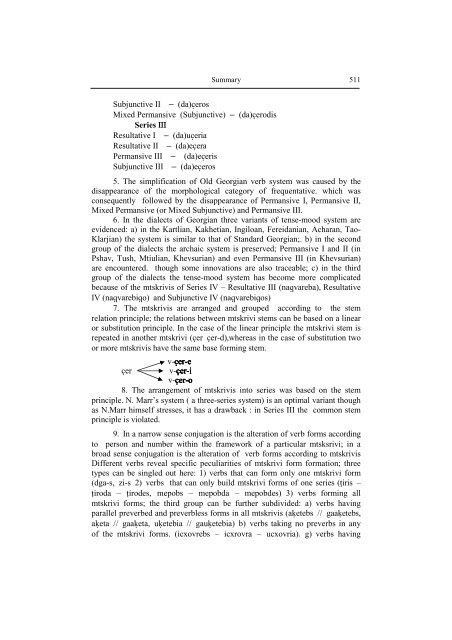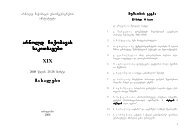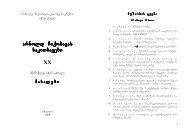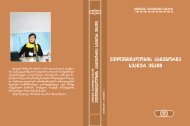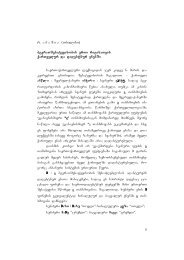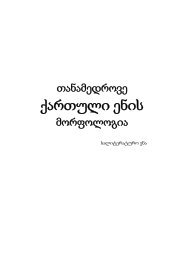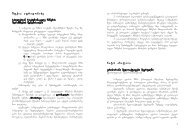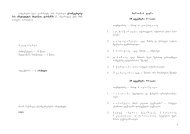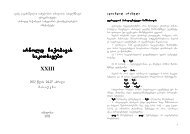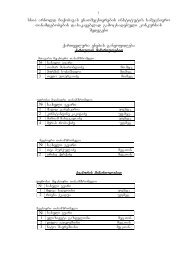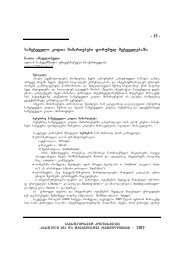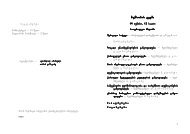- Page 1 and 2:
arn. Ciqobavas saxelobis enaTmecnie
- Page 3 and 4:
g i o r g i g o g o l a S v i l i q
- Page 5 and 6:
qarTuli zmnis sarkvevi profesorma g
- Page 7 and 8:
Sesavali * * * cnobili yeSmaritebaa
- Page 9 and 10:
Sesavali Semd.). CvenTvis faseulia
- Page 11 and 12:
Sesavali aT ri rigad ri gad gad~...
- Page 13 and 14:
Sesavali da sworad Sefasebis saqmeS
- Page 15 and 16:
Sesavali ara aqvs, igi cnebis gadmo
- Page 17 and 18:
Sesavali 4. II kavSirebiTi 5. Sereu
- Page 19 and 20:
Sesavali vaKenebT XII-XVII saukuneT
- Page 21 and 22:
Sesavali xis koines, idioleqts. aq
- Page 23 and 24:
Sesavali Kvela im parametris mixedv
- Page 25 and 26:
Sesavali 2) Tu vsaubrobT qar ar arT
- Page 27 and 28:
Sesavali SromebSi zog SemTxvevaSi Z
- Page 29 and 30:
Sesavali zmnisa, romelic saerToa er
- Page 31 and 32:
Sesavali enobri enob enob enobri ri
- Page 33 and 34:
Sesavali ufro sainteresod gveCveneb
- Page 35 and 36:
Sesavali 1. rogorc viciT, e xmovani
- Page 37 and 38:
Sesavali Zveli qarTuli enis werilob
- Page 39:
nawili nawili nawili pirveli pirvel
- Page 44 and 45:
42 g. g o g o l a S v i l i. qarTul
- Page 46 and 47:
44 g. g o g o l a S v i l i. qarTul
- Page 48 and 49:
46 g. g o g o l a S v i l i. qarTul
- Page 50 and 51:
48 g. g o g o l a S v i l i. qarTul
- Page 52 and 53:
50 g. g o g o l a S v i l i. qarTul
- Page 54 and 55:
52 anda: g. g o g o l a S v i l i.
- Page 56 and 57:
54 g. g o g o l a S v i l i. qarTul
- Page 58 and 59:
56 g. g o g o l a S v i l i. qarTul
- Page 60 and 61:
58 g. g o g o l a S v i l i. qarTul
- Page 62 and 63:
60 g. g o g o l a S v i l i. qarTul
- Page 64 and 65:
62 g. g o g o l a S v i l i. qarTul
- Page 66 and 67:
64 g. g o g o l a S v i l i. qarTul
- Page 68 and 69:
66 g. g o g o l a S v i l i. qarTul
- Page 70 and 71:
68 g. g o g o l a S v i l i. qarTul
- Page 72 and 73:
70 g. g o g o l a S v i l i. qarTul
- Page 74 and 75:
72 g. g o g o l a S v i l i. qarTul
- Page 76 and 77:
74 g. g o g o l a S v i l i. qarTul
- Page 78 and 79:
76 g. g o g o l a S v i l i. qarTul
- Page 80 and 81:
78 g. g o g o l a S v i l i. qarTul
- Page 82 and 83:
80 g. g o g o l a S v i l i. qarTul
- Page 84 and 85:
82 g. g o g o l a S v i l i. qarTul
- Page 86 and 87:
84 g. g o g o l a S v i l i. qarTul
- Page 88 and 89:
86 g. g o g o l a S v i l i. qarTul
- Page 90 and 91:
88 1. 2. 3. 4. 5. 6. 7. 8. 9. 10. 1
- Page 92 and 93:
90 g. g o g o l a S v i l i. qarTul
- Page 94 and 95:
92 g. g o g o l a S v i l i. qarTul
- Page 96 and 97:
94 g. g o g o l a S v i l i. qarTul
- Page 98 and 99:
96 g. g o g o l a S v i l i. qarTul
- Page 100 and 101:
98 g. g o g o l a S v i l i. qarTul
- Page 102 and 103:
100 g. g o g o l a S v i l i. qarTu
- Page 104 and 105:
102 g. g o g o l a S v i l i. qarTu
- Page 106 and 107:
104 g. g o g o l a S v i l i. qarTu
- Page 108 and 109:
106 g. g o g o l a S v i l i. qarTu
- Page 110 and 111:
108 g. g o g o l a S v i l i. qarTu
- Page 112 and 113:
110 g. g o g o l a S v i l i. qarTu
- Page 114 and 115:
112 g. g o g o l a S v i l i. qarTu
- Page 116 and 117:
114 g. g o g o l a S v i l i. qarTu
- Page 118 and 119:
116 g. g o g o l a S v i l i. qarTu
- Page 120 and 121:
118 g. g o g o l a S v i l i. qarTu
- Page 122 and 123:
120 g. g o g o l a S v i l i. qarTu
- Page 124 and 125:
122 g. g o g o l a S v i l i. qarTu
- Page 126 and 127:
124 g. g o g o l a S v i l i. qarTu
- Page 128 and 129:
126 g. g o g o l a S v i l i. qarTu
- Page 130 and 131:
128 g. g o g o l a S v i l i. qarTu
- Page 132 and 133:
130 g. g o g o l a S v i l i. qarTu
- Page 134 and 135:
132 g. g o g o l a S v i l i. qarTu
- Page 136 and 137:
134 g. g o g o l a S v i l i. qarTu
- Page 138 and 139:
136 g. g o g o l a S v i l i. qarTu
- Page 140 and 141:
138 g. g o g o l a S v i l i. qarTu
- Page 142 and 143:
140 g. g o g o l a S v i l i. qarTu
- Page 144 and 145:
142 g. g o g o l a S v i l i. qarTu
- Page 146 and 147:
144 g. g o g o l a S v i l i. qarTu
- Page 148 and 149:
146 g. g o g o l a S v i l i. qarTu
- Page 150 and 151:
148 g. g o g o l a S v i l i. qarTu
- Page 152 and 153:
150 g. g o g o l a S v i l i. qarTu
- Page 154 and 155:
152 g. g o g o l a S v i l i. qarTu
- Page 156 and 157:
154 g. g o g o l a S v i l i. qarTu
- Page 158 and 159:
156 g. g o g o l a S v i l i. qarTu
- Page 160 and 161:
158 g. g o g o l a S v i l i. qarTu
- Page 162 and 163:
160 g. g o g o l a S v i l i. qarTu
- Page 164 and 165:
162 g. g o g o l a S v i l i. qarTu
- Page 166 and 167:
164 g. g o g o l a S v i l i. qarTu
- Page 168 and 169:
166 g. g o g o l a S v i l i. qarTu
- Page 170 and 171:
168 g. g o g o l a S v i l i. qarTu
- Page 172 and 173:
170 g. g o g o l a S v i l i. qarTu
- Page 174 and 175:
172 g. g o g o l a S v i l i. qarTu
- Page 176 and 177:
174 g. g o g o l a S v i l i. qarTu
- Page 178 and 179:
176 g. g o g o l a S v i l i. qarTu
- Page 180 and 181:
178 g. g o g o l a S v i l i. qarTu
- Page 182 and 183:
180 g. g o g o l a S v i l i. qarTu
- Page 184 and 185:
182 g. g o g o l a S v i l i. qarTu
- Page 186 and 187:
184 g. g o g o l a S v i l i. qarTu
- Page 188 and 189:
186 g. g o g o l a S v i l i. qarTu
- Page 190 and 191:
188 g. g o g o l a S v i l i. qarTu
- Page 192 and 193:
190 g. g o g o l a S v i l i. qarTu
- Page 194 and 195:
192 g. g o g o l a S v i l i. qarTu
- Page 196 and 197:
194 g. g o g o l a S v i l i. qarTu
- Page 198 and 199:
196 g. g o g o l a S v i l i. qarTu
- Page 200 and 201:
198 g. g o g o l a S v i l i. qarTu
- Page 202 and 203:
200 g. g o g o l a S v i l i. qarTu
- Page 204 and 205:
202 g. g o g o l a S v i l i. qarTu
- Page 206 and 207:
204 g. g o g o l a S v i l i. qarTu
- Page 208 and 209:
206 g. g o g o l a S v i l i. qarTu
- Page 210 and 211:
208 g. g o g o l a S v i l i. qarTu
- Page 212 and 213:
210 g. g o g o l a S v i l i. qarTu
- Page 214 and 215:
212 g. g o g o l a S v i l i. qarTu
- Page 216 and 217:
214 g. g o g o l a S v i l i. qarTu
- Page 218 and 219:
216 g. g o g o l a S v i l i. qarTu
- Page 220 and 221:
218 g. g o g o l a S v i l i. qarTu
- Page 222 and 223:
220 g. g o g o l a S v i l i. qarTu
- Page 224 and 225:
222 g. g o g o l a S v i l i. qarTu
- Page 226 and 227:
224 boboqr-ob-d-i-T boboqr-ob-d-nen
- Page 228 and 229:
226 _ _ _ g. g o g o l a S v i l i.
- Page 230 and 231:
228 g. g o g o l a S v i l i. qarTu
- Page 232 and 233:
230 g. g o g o l a S v i l i. qarTu
- Page 234 and 235:
232 g. g o g o l a S v i l i. qarTu
- Page 236 and 237:
234 awmKo awmKo-mKofadi awmKo mKofa
- Page 238 and 239:
236 g. g o g o l a S v i l i. qarTu
- Page 240 and 241:
238 ƒam ƒam rwam rwam dga dga g.
- Page 242 and 243:
240 g. g o g o l a S v i l i. qarTu
- Page 246:
nawili nawili nawili meore meore me
- Page 251 and 252:
246 g. g o g o l a S v i l i. qarTu
- Page 253 and 254:
248 g. g o g o l a S v i l i. qarTu
- Page 255 and 256:
250 g. g o g o l a S v i l i. qarTu
- Page 257 and 258:
252 g. g o g o l a S v i l i. qarTu
- Page 259 and 260:
254 g. g o g o l a S v i l i. qarTu
- Page 261 and 262:
256 g. g o g o l a S v i l i. qarTu
- Page 263 and 264:
258 g. g o g o l a S v i l i. qarTu
- Page 265 and 266:
260 g. g o g o l a S v i l i. qarTu
- Page 267 and 268:
262 g. g o g o l a S v i l i. qarTu
- Page 269 and 270:
264 g. g o g o l a S v i l i. qarTu
- Page 271 and 272:
266 g. g o g o l a S v i l i. qarTu
- Page 273 and 274:
268 g. g o g o l a S v i l i. qarTu
- Page 275 and 276:
270 g. g o g o l a S v i l i. qarTu
- Page 277 and 278:
272 g. g o g o l a S v i l i. qarTu
- Page 279 and 280:
274 g. g o g o l a S v i l i. qarTu
- Page 281 and 282:
276 g. g o g o l a S v i l i. qarTu
- Page 283 and 284:
278 g. g o g o l a S v i l i. qarTu
- Page 285 and 286:
280 g. g o g o l a S v i l i. qarTu
- Page 287 and 288:
282 g. g o g o l a S v i l i. qarTu
- Page 289 and 290:
284 g. g o g o l a S v i l i. qarTu
- Page 291 and 292:
286 g. g o g o l a S v i l i. qarTu
- Page 293 and 294:
288 g. g o g o l a S v i l i. qarTu
- Page 295 and 296:
290 g. g o g o l a S v i l i. qarTu
- Page 297 and 298:
292 g. g o g o l a S v i l i. qarTu
- Page 299 and 300:
294 g. g o g o l a S v i l i. qarTu
- Page 301 and 302:
296 g. g o g o l a S v i l i. qarTu
- Page 303 and 304:
298 g. g o g o l a S v i l i. qarTu
- Page 305 and 306:
300 g. g o g o l a S v i l i. qarTu
- Page 307 and 308:
302 g. g o g o l a S v i l i. qarTu
- Page 309 and 310:
304 g. g o g o l a S v i l i. qarTu
- Page 311 and 312:
306 g. g o g o l a S v i l i. qarTu
- Page 313 and 314:
308 g. g o g o l a S v i l i. qarTu
- Page 315 and 316:
310 g. g o g o l a S v i l i. qarTu
- Page 317 and 318:
312 g. g o g o l a S v i l i. qarTu
- Page 319 and 320:
314 g. g o g o l a S v i l i. qarTu
- Page 321 and 322:
316 g. g o g o l a S v i l i. qarTu
- Page 323 and 324:
318 g. g o g o l a S v i l i. qarTu
- Page 325 and 326:
320 g. g o g o l a S v i l i. qarTu
- Page 327 and 328:
322 g. g o g o l a S v i l i. qarTu
- Page 329 and 330:
324 g. g o g o l a S v i l i. qarTu
- Page 331 and 332:
326 g. g o g o l a S v i l i. qarTu
- Page 333 and 334:
328 g. g o g o l a S v i l i. qarTu
- Page 335 and 336:
330 g. g o g o l a S v i l i. qarTu
- Page 337 and 338:
332 g. g o g o l a S v i l i. qarTu
- Page 339 and 340:
334 g. g o g o l a S v i l i. qarTu
- Page 341 and 342:
336 g. g o g o l a S v i l i. qarTu
- Page 343 and 344:
338 III. v-i-c-i i-c-i i-c-i-s v-i-
- Page 345 and 346:
340 zi-xar zi-s g. g o g o l a S v
- Page 347 and 348:
342 g. g o g o l a S v i l i. qarTu
- Page 349 and 350:
344 g. g o g o l a S v i l i. qarTu
- Page 351 and 352:
346 g. g o g o l a S v i l i. qarTu
- Page 353 and 354:
348 g. g o g o l a S v i l i. qarTu
- Page 355 and 356:
350 g. g o g o l a S v i l i. qarTu
- Page 357 and 358:
352 g. g o g o l a S v i l i. qarTu
- Page 359 and 360:
354 g. g o g o l a S v i l i. qarTu
- Page 361 and 362:
Tavi Tavi VV. V . II seriis formaTa
- Page 363 and 364:
358 g. g o g o l a S v i l i. qarTu
- Page 365 and 366:
360 bic: g. g o g o l a S v i l i.
- Page 367 and 368:
362 g. g o g o l a S v i l i. qarTu
- Page 369 and 370:
364 g. g o g o l a S v i l i. qarTu
- Page 371 and 372:
366 g. g o g o l a S v i l i. qarTu
- Page 373 and 374:
368 g. g o g o l a S v i l i. qarTu
- Page 375 and 376:
370 g. g o g o l a S v i l i. qarTu
- Page 377 and 378:
372 g. g o g o l a S v i l i. qarTu
- Page 379 and 380:
374 g. g o g o l a S v i l i. qarTu
- Page 381 and 382:
376 g. g o g o l a S v i l i. qarTu
- Page 383 and 384:
378 g. g o g o l a S v i l i. qarTu
- Page 385 and 386:
380 g. g o g o l a S v i l i. qarTu
- Page 387 and 388:
382 g. g o g o l a S v i l i. qarTu
- Page 389 and 390:
384 g. g o g o l a S v i l i. qarTu
- Page 391 and 392:
386 g. g o g o l a S v i l i. qarTu
- Page 393 and 394:
388 g. g o g o l a S v i l i. qarTu
- Page 395 and 396:
390 g. g o g o l a S v i l i. qarTu
- Page 397 and 398:
392 g. g o g o l a S v i l i. qarTu
- Page 399 and 400:
394 g. g o g o l a S v i l i. qarTu
- Page 401 and 402:
396 g. g o g o l a S v i l i. qarTu
- Page 403 and 404:
398 g. g o g o l a S v i l i. qarTu
- Page 405 and 406:
400 g. g o g o l a S v i l i. qarTu
- Page 407 and 408:
402 g. g o g o l a S v i l i. qarTu
- Page 409 and 410:
404 g. g o g o l a S v i l i. qarTu
- Page 411 and 412:
406 g. g o g o l a S v i l i. qarTu
- Page 413 and 414:
408 g. g o g o l a S v i l i. qarTu
- Page 415 and 416:
410 g. g o g o l a S v i l i. qarTu
- Page 417 and 418:
412 g. g o g o l a S v i l i. qarTu
- Page 419 and 420:
414 g. g o g o l a S v i l i. qarTu
- Page 421 and 422:
416 g. g o g o l a S v i l i. qarTu
- Page 423 and 424:
418 g. g o g o l a S v i l i. qarTu
- Page 425 and 426:
420 g. g o g o l a S v i l i. qarTu
- Page 427 and 428:
422 g. g o g o l a S v i l i. qarTu
- Page 429 and 430:
424 g. g o g o l a S v i l i. qarTu
- Page 431 and 432:
426 g. g o g o l a S v i l i. qarTu
- Page 433 and 434:
428 g. g o g o l a S v i l i. qarTu
- Page 435 and 436:
430 g. g o g o l a S v i l i. qarTu
- Page 437 and 438:
432 sxva magaliTi: g. g o g o l a S
- Page 439 and 440:
434 g. g o g o l a S v i l i. qarTu
- Page 441 and 442:
436 da-m-e-wer-i-s da-g-e-wer-i-s d
- Page 443 and 444:
438 g. g o g o l a S v i l i. qarTu
- Page 445 and 446:
440 g. g o g o l a S v i l i. qarTu
- Page 447 and 448:
442 g. g o g o l a S v i l i. qarTu
- Page 449 and 450:
444 g. g o g o l a S v i l i. qarTu
- Page 451 and 452:
446 g. g o g o l a S v i l i. qarTu
- Page 453 and 454:
448 g. g o g o l a S v i l i. qarTu
- Page 455 and 456:
450 g. g o g o l a S v i l i. qarTu
- Page 457 and 458:
452 g. g o g o l a S v i l i. qarTu
- Page 459 and 460:
454 g. g o g o l a S v i l i. qarTu
- Page 461 and 462:
Ta Tavi Ta vi vi VVI. V . III serii
- Page 463 and 464: 458 II II Tur Turme Tur Turme meobi
- Page 465 and 466: 460 uwKveteli: I kavSirebiTi: wKvet
- Page 467 and 468: 462 g. g o g o l a S v i l i. qarTu
- Page 469 and 470: 464 g. g o g o l a S v i l i. qarTu
- Page 471 and 472: 466 g. g o g o l a S v i l i. qarTu
- Page 473 and 474: 468 g. g o g o l a S v i l i. qarTu
- Page 475 and 476: 470 g. g o g o l a S v i l i. qarTu
- Page 477 and 478: 472 g. g o g o l a S v i l i. qarTu
- Page 479 and 480: 474 g. g o g o l a S v i l i. qarTu
- Page 481 and 482: 476 damalul ars damalul varT damalu
- Page 483 and 484: 478 g. g o g o l a S v i l i. qarTu
- Page 485 and 486: 480 g. g o g o l a S v i l i. qarTu
- Page 487 and 488: 482 g. g o g o l a S v i l i. qarTu
- Page 489 and 490: 484 g. g o g o l a S v i l i. qarTu
- Page 491 and 492: 486 g. g o g o l a S v i l i. qarTu
- Page 493 and 494: 488 g. g o g o l a S v i l i. qarTu
- Page 495 and 496: 490 g. g o g o l a S v i l i. qarTu
- Page 497 and 498: 492 g. g o g o l a S v i l i. qarTu
- Page 499 and 500: 494 g. g o g o l a S v i l i. qarTu
- Page 501 and 502: 496 g. g o g o l a S v i l i. qarTu
- Page 503 and 504: 498 g. g o g o l a S v i l i. qarTu
- Page 505 and 506: 500 g. g o g o l a S v i l i. qarTu
- Page 507 and 508: 502 g. g o g o l a S v i l i. qarTu
- Page 509 and 510: Semoklebani i. . abaS abaS. abaS _
- Page 511 and 512: 506 g. g o g o l a S v i l i. qarTu
- Page 513: GIORGI GOGOLASHVILI GEORGIAN VERB (
- Page 517 and 518: Sinaarsi qarTuli qarTuli zmnis zmni
- Page 519 and 520: Sinaarsi 6.3. uGlebis nimuSebi Zvel
- Page 521 and 522: Sinaarsi 14.4. savrcobTa gamoKeneba
- Page 523: Sinaarsi Tavi VI. III seriis seriis


